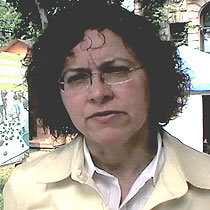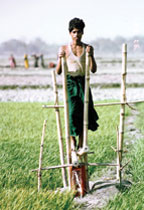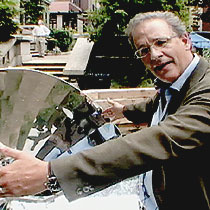2007年VOA标准英语-Tools to Improve Lives, Health in the Developin
时间:2019-01-04 作者:英语课 分类:2007年VOA标准英语(八月)
New York
09 August 2007
Design is a topic most often associated with luxury goods. But an exhibit at the Cooper-Hewitt National Design Museum in New York focuses on innovative 2 ways to address the needs of the world's poor. The objects on display represent a new trend in design, one that mixes sustainable and recycled materials with ancient knowledge and high technology.

The Cooper-Hewitt's Cynthia Smith curated the exhibit
The United Nations says 90 percent of the world's population lacks the money to buy even the most basic goods. Life is an endless struggle to get enough water, food, cooking fuel and shelter just to survive.
The outdoor exhibit at the Cooper-Hewitt National Design Museum displays tools to meet those needs, and others that address education, better health, and income-generating work. "The kind of design that's in the show, Design for the Other 90%, really can impact people's lives,” curator Cynthia Smith says. “It can improve lives and even save lives."
For transporting things, there is the Boda bicycle, built long and with a low center of gravity. It can handle large loads of goods, or two passengers in addition to the bicyclist. For carrying water home, there's the Q Drum, a plastic container shaped like a ring or doughnut, with a hole in the middle.
“You put the water inside the doughnut,” Smith says, “and then you roll it along the ground -- as opposed to putting it on your head, or pushing it with a wheelbarrow."

Micro-irrigation devices on display include this foot-operated bamboo treadle pump for drawing up ground water
The life-straw makes dirty water safe to drink in the time it takes to draw it up from a pond or puddle 3. Solar-powered lights are woven into a flexible portable light mat, so that people can read or work at night. And for growing food even during a drought, there are micro-irrigation devices on display, including a bamboo treadle pump.
"You use it with a walking motion,” Smith says. “It brings water up from the ground, costs roughly $40. Over two million are in use today. The impact for that one is that in Bangladesh alone, they've increased their net income by $1.4 billion."
The pot-in-pot cooler keeps vegetables fresh for days -- making it possible to earn money from produce that would otherwise spoil before it could be brought to market. "It's designed by Mohammed Bah Abba, an engineer out of Nigeria,” Smith says. “It's one ceramic 4 pot inside another ceramic pot. Between the two pots, there's sand. You pour water into the sand, and as the air evaporates, the hot air escapes from the center of the pot, and leaves cool air."
Sergio Palleroni is an architecture professor who designs for poor communities. His group's solar cooker is made from scrap 5 metal, and uses the same principle. Standing 6 in front of the cooker, which looks like a mirrored satellite dish with a small black pot hanging in the middle, Palleroni explains how it works.

Architect Sergio Palleroni designs for poor and squatter communities
“You turn it to where the line of sun is straight to the center, and then all the rays of the sun will come, reflect, and then hit the black surface [of the pot at the center] and heat it up. So, that's why it's on a stand. You rotate it around and focus it, and then essentially 8 for half an hour or an hour, while the sun is still in that general path, you have a super-efficient stove."
The cooker is faster than an ordinary stove, and saves both trees and the hours people formerly 9 spent searching for fuel. Hundreds of families can cook at once on giant versions, which follow the sun with clockwork mechanisms 10 made of bicycle parts. While the sun’s heat concentrates on a long metal cooking bar, the rest of the device remains 11 cool. "It allows people to cook from what's really abundant along the equatorial belt,” Palleroni says. “Most poverty happens along the equatorial belt. And one resource you have in abundance is the sun."
Other highlights of the show include a fleet of motorcycles that carry wireless 12 Internet from village to village, and furniture built of wood salvaged 13 after Hurricane Katrina.
- She was a fast weaver and the cloth was very good.她织布织得很快,而且布的质量很好。
- The eager weaver did not notice my confusion.热心的纺织工人没有注意到我的狼狈相。
- Discover an innovative way of marketing.发现一个创新的营销方式。
- He was one of the most creative and innovative engineers of his generation.他是他那代人当中最富创造性与革新精神的工程师之一。
- The boy hopped the mud puddle and ran down the walk.这个男孩跳过泥坑,沿着人行道跑了。
- She tripped over and landed in a puddle.她绊了一下,跌在水坑里。
- The order for ceramic tiles has been booked in.瓷砖的订单已登记下来了。
- Some ceramic works of art are shown in this exhibition.这次展览会上展出了一些陶瓷艺术品。
- A man comes round regularly collecting scrap.有个男人定时来收废品。
- Sell that car for scrap.把那辆汽车当残品卖了吧。
- After the earthquake only a few houses were left standing.地震过后只有几幢房屋还立着。
- They're standing out against any change in the law.他们坚决反对对法律做任何修改。
- The squatter settlements originally came into being through illegal land invasions. 违章建筑区最初是通过非法的土地占有而形成的。
- Squatter control is maintained by regular patrols and hut-to-hut checks. 当局定期逐户视察所有寮屋,以收管制之效。
- Really great men are essentially modest.真正的伟人大都很谦虚。
- She is an essentially selfish person.她本质上是个自私自利的人。
- We now enjoy these comforts of which formerly we had only heard.我们现在享受到了过去只是听说过的那些舒适条件。
- This boat was formerly used on the rivers of China.这船从前航行在中国内河里。
- The research will provide direct insight into molecular mechanisms. 这项研究将使人能够直接地了解分子的机理。 来自《简明英汉词典》
- He explained how the two mechanisms worked. 他解释这两台机械装置是如何工作的。 来自《简明英汉词典》
- He ate the remains of food hungrily.他狼吞虎咽地吃剩余的食物。
- The remains of the meal were fed to the dog.残羹剩饭喂狗了。
- There are a lot of wireless links in a radio.收音机里有许多无线电线路。
- Wireless messages tell us that the ship was sinking.无线电报告知我们那艘船正在下沉。